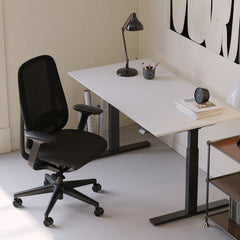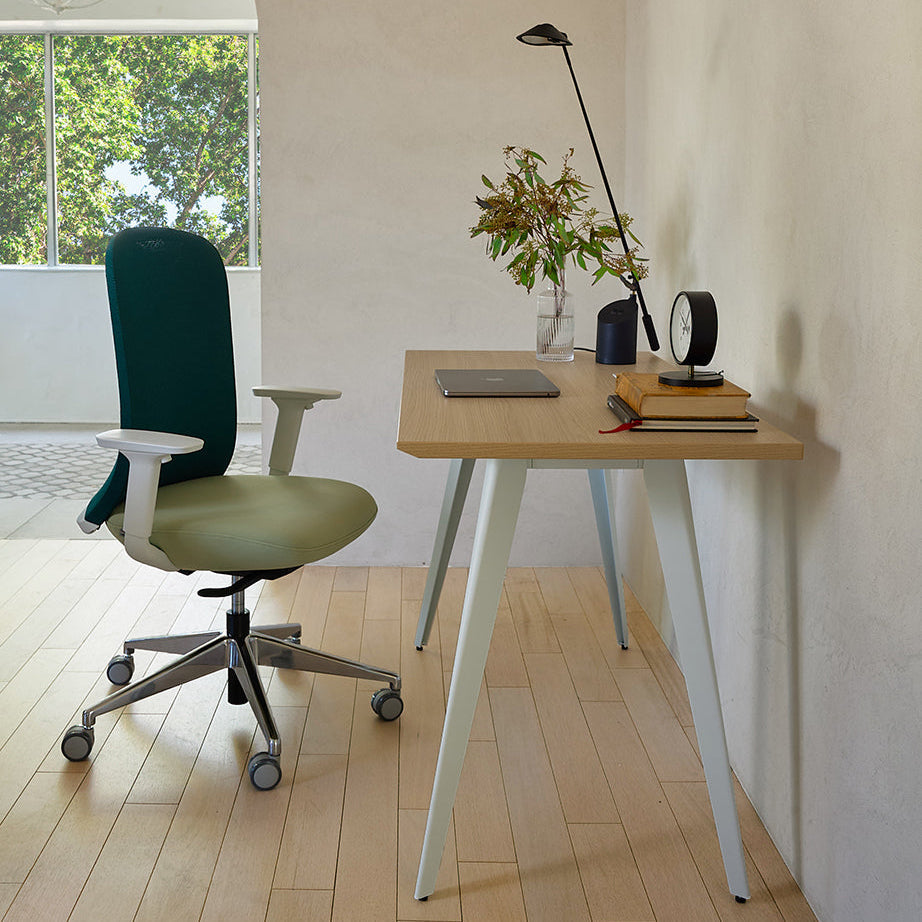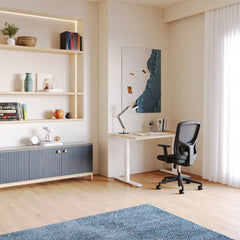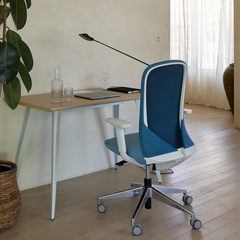Get 10% off your first order
Find the office furniture that’s designed to match your style, comfort, and needs perfectly. Subscribe
Blending Comfort, Quality, and Modern Style

Visit quiz page to see how we makes it easy to create an inspiring workplace


For decades, the phrase "form follows function" has been the mantra of design. In modern furniture, this relationship is no longer a simple follow-up; it is a dynamic, integrated partnership. Today's designers don't just ask, "What does it look like?" they ask, "How does it improve the way a person lives, works, and feels?" This intense focus on the user experience has transformed furniture from static objects into responsive, ergonomic tools.
Modern design elevates the everyday, blending clean aesthetics with hidden utility. It demands that a piece be beautiful enough to admire and smart enough to support a dynamic lifestyle. This article explores the core principles that define contemporary furniture design, showing how intentional choices in material, geometry, and utility result in pieces that are both timeless and highly functional.
The driving force behind this evolution is the focus on the user's well-being and productivity. Furniture must adapt to the human body, not the other way around. This principle guides everything from the curve of a chair back to the mechanical properties of a desk. When design is truly successful, the functionality feels intuitive, and the piece disappears into the background of a comfortable, focused life.
This evolution is perfectly embodied by dynamic workspaces. A height-adjustable standing desk demonstrates the commitment to functionality by adapting to the user's changing posture, proving that movement and support are now integral parts of modern design.
Modern furniture design emphasizes minimalism—the deliberate reduction of elements to achieve clarity. This is not just an artistic choice; it is a functional one. Fewer visual details translate to less visual clutter, which helps promote mental focus and calm in the living space.
Modern pieces favor geometric shapes, clean lines, and neutral color palettes. The beauty lies in the quality of the materials and the precision of the construction, not in ornamentation.
Clarity: Every element is necessary; nothing is superfluous.
Space: Negative space is utilized as a design component to give pieces "room to breathe."
Function: The shape of the furniture clearly communicates its intended purpose.
Ergonomics is no longer an optional add-on; it is a fundamental pillar of modern furniture. Design must actively support the user's musculoskeletal health during long periods of use, whether sitting or working.
Modern seating and desks are engineered to promote neutral posture, minimizing strain on the spine, neck, and shoulders. This requires precise measurements and integrated adjustability that fits a wide range of body types.
Ergonomic Design Checklist:
☐ Lumbar Support: Built-in or highly adjustable support that matches the spine's natural curve.
☐ Dynamic Movement: Features that encourage slight shifts in posture, preventing muscle stagnation.
☐ Height Synchronization: Pieces designed to align perfectly with each other for correct elbow and eye level.
☐ Edge Comfort: Contoured or rounded edges to prevent pressure points on forearms and legs.
Modern design prioritizes material honesty, showcasing the natural beauty and structural integrity of the components. This often involves combining wood, metal, glass, and durable fabrics in complementary ways.
The classic modern fusion pairs the warmth and organic texture of wood (like walnut or oak) with the strength and sleekness of metal (steel or aluminum). This combination satisfies the human need for both natural elements and technological robustness.
This interplay of materials is visible in functional pieces, where a sophisticated modern office desk uses a sturdy metal base for stability and a rich wood top for warmth and comfort, perfectly uniting form and function.
Today's living spaces are shrinking and becoming multi-functional, requiring furniture to be highly adaptable. A single piece must often serve as a dining table, a workspace, and a console.
Modern furniture achieves adaptability through modularity, folding mechanisms, and height adjustment, ensuring that the piece remains valuable and relevant even as the room's function changes.
The challenge of maximizing small spaces without sacrificing ergonomic function is met by precise engineering. A space-conscious solution like a Mini Standing Desk California is designed to offer the full functionality of dynamic working while occupying a minimal footprint, proving that intelligent design is key to compact living.

Modern furniture design includes an ethical mandate: efficiency in production to minimize environmental impact and waste. Sustainability is baked into the design process, from sourcing to construction.
Focus shifts to using durable, high-quality materials and smart manufacturing techniques that reduce cutting waste. The best environmental choice is a product built so well it never needs replacing.
Sustainable Design Principles (Checklist):
☐ Modular Construction: Allows for easy repair and replacement of individual components.
☐ Durable Finishes: Resists wear and tear, extending the product's aesthetic life.
☐ Material Efficiency: Designs that minimize offcuts and excess material use.
☐ Recycled Content: Use of recycled aluminum, steel, and plastics where appropriate.
Beyond simple cushioning, modern design uses biomechanical engineering to create comfort. This involves analyzing body pressure points, spinal alignment, and muscular engagement to optimize seated or working positions.
Designers use scientific data to determine ideal seating angles, lumbar curves, and weight distribution. The goal is to reduce static load and encourage subtle muscle movement that maintains circulation and alertness.
While traditional furniture is analog, modern smart furniture integrates technology seamlessly—not just for charging, but for enhancing core function. This requires hiding the mechanics and wiring to maintain clean aesthetics.
The use of quiet, motorized adjustment systems and discreet cable management trays in modern desks ensures that the technology aids the function without dominating the visual space. All of the intelligence is placed beneath the surface.
Modern living often involves shared workspaces or collaborative home environments. Furniture design now addresses the need for multiple users in a cohesive, functional space.
Pieces must allow for individual focus while maintaining spatial harmony. This is evident in larger, shared workstations. A specialized solution like a two-person standing office desk provides separate, independently controlled ergonomic zones, allowing two individuals to work side-by-side without compromising their individual comfort or posture needs.
The look and feel of modern furniture directly impacts the user's cognitive state. Clean lines, natural materials, and organized space contribute to a reduction in stress and an improvement in concentration.
By minimizing visual noise and maximizing comfort, modern design reduces the cognitive load associated with a chaotic environment. Research confirms that control and a supportive environment are crucial psychological resources. As highlighted in work psychology journals, providing a comfortable and controllable physical workspace is fundamentally linked to increased job engagement and a reduced risk of burnout.
True modern design rejects obsolescence. By focusing on clean forms, durable materials, and essential functionality, the pieces remain relevant long after passing trends have faded, making them an investment in permanent style.
When function guides form, the result is classic. A well-designed piece of modern furniture from today will likely fit just as well into a home decorated decades from now because its utility is fundamental and its lines are pure. It is the ultimate expression of thoughtful, enduring design.

Modern furniture design is the art of the essential. It is a commitment to pieces that don't just fill a space, but actively contribute to a better quality of life. By merging ergonomic necessity with minimalist elegance, designers create objects that are durable, adaptable, and beautifully simple. When you invest in furniture where form truly serves function, you invest in a smarter, healthier, and more focused way of living. Choose intelligence; choose modern design.

Blending Comfort, Quality, and Modern Style

Unclutter Your Life: The Simple Genius of Modern Furniture

The Intelligent Evolution of Home Furniture
Get 10% off your first order
Find the office furniture that’s designed to match your style, comfort, and needs perfectly. Subscribe
Leave a comment